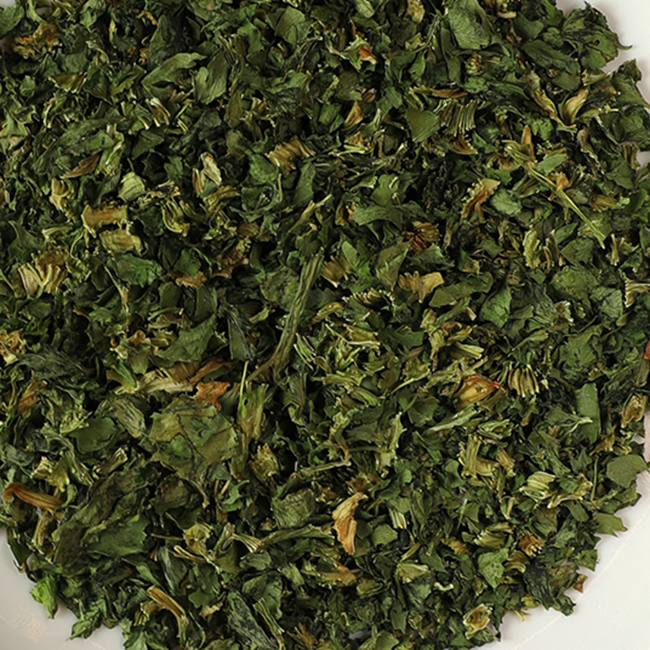How to increase the hatching rate of ostriches
Scientific feeding and management The nutritional level of nutritionally balanced ostriches is a fundamental factor affecting the hatching rate. The requirement for metabolic energy in feed for ostrich breeding is 11.3 kJ/kg, and crude fat should be limited to 6%-8%; 18%-24%, while paying attention to the supply of several amino acids (%): arginine 1.04, lysine 0.86, methionine + cystine 0.73, phenylalanine 0.95, proline 1.02; crude fiber content For 10%, calcium 4%-4.5%, available phosphorus 0.4%, sodium 0.3%, magnesium 0.25%, vitamin E 80 international units / kg, should pay attention to the quality of green feed, appropriate supplement pantothenic acid and other trace elements. According to studies, adult ostriches in the breeding season, the nutritional content of the diet fed is low-energy, high-protein, high-fiber, and use meat and bone meal, blood meal instead of fish meal, you can get a higher hatching rate.
Air-dried celery is a high-fiber food. It produces a substance of lignin or intestinal fat through intestinal digestion. This substance is an antioxidant. Eating celery often, especially eating celery leaves, can prevent high blood pressure, arteries Sclerosis, etc. are very beneficial, and have the role of adjuvant therapy.
Air Dried Celery,Dried Celery,Dehydrated Celery,Organic Dried Celery Topower Technology Limited , https://www.topower-foods.com
Healthy management First, you should maintain proper exercise and control your weight. Ostriches should prevent overweight or overweight when laying eggs, otherwise they will affect reproduction. Second, the proportion of males to females should be reasonable, usually 1:2. If males are indeed excellent, they can be increased to 1:3-4. Finally, daily management should be strengthened, ostrich egg nests should be properly set up, manure and quail eggs should be removed in time, aviaries should be kept clean and dry, bacterial contamination should be prevented, and public birds with no fertility or lack of “climbing†capability must be eliminated. During the breeding of ostriches, do not arbitrarily change the bar, change breeders, or drive ostriches suddenly to avoid stress such as frightening ostriches. Disinfect aviaries and sports grounds on a regular basis, quarantine and prevent epidemics, and maintain the health of birds.
Strict selection of eggs must be derived from good, healthy birds. When selecting eggs, first lay eggs, shell eggs, preserved eggs, and eggs that are too large, too small, too flat, too round, and have too large a contaminated area. . For freshly-produced eggs should not be immediately hatched, to store more than 24 hours, but it is best not more than 6 days, the preservation temperature of 15 °C is appropriate. If the shelf life is longer than 6 days, the temperature should be lowered. The relative humidity of the preserved eggs should be 70%-80%, and the storage room should be ventilated. When the eggs are kept, they should head down and flip once a day.
Improving Sanitizing and Disinfection Measures Sterilization of ostrich egg storage rooms Wipe the floor once every two days with disinfectant, thoroughly clean and disinfect for two weeks, and fumigate with formalin solution.
When eggs are used to disinfect ostriches, the breeder shall use sterile gauze to catch them and then send them to the incubator for disinfection. The disinfection dose is 37% formalin, 42 ml, and 21 g potassium permanganate for 30 minutes. If not, wipe the surface dirt with a gauze soaked in disinfectant and immediately send it to the incubator for disinfection. Before incubating, soak for 20-30 seconds with a disinfectant (temperature not exceeding 40°C), then dry the eggs with a sterile dry gauze and incubate.
Incubator disinfection The incubator floor is wiped once every two days with a disinfectant. Walls and ceilings are sprayed once every half a month with disinfectant and once a month.
Disinfection of the incubator Prior to each incubation, the inside and outside of the incubator and the surface should be wiped with a disinfectant and then formalin-based fumigation.
Appropriate incubation conditions The appropriate temperature experience shows that at room temperature 18 °C -25 °C, if the use of constant temperature incubation method, the incubation temperature is best controlled at 37 °C, with the room temperature, incubation temperature can be reduced appropriately. Variable temperature incubation method can also be used to divide the incubation period into the early, middle and late stages. The temperature can be controlled to 36.5°C, 36°C, and 35.5°C respectively. The relative humidity is 22%, 23% and 25%, respectively, and the eggs can be According to the three grades of large, medium, small or heavy, medium and light, the extension hatching can increase the hatching rate and the rate of health-care.
Suitable Humidity For constant temperature incubation, the pre-incubation humidity can be controlled at 20% to 25%, and the humidity of the transfer to the hatching machine should be relatively high, usually 30% to 40%, and the relatively high humidity at the later stage is favorable for the chick pecking.
Reasonable ventilation and cold embryonic embryo development require fresh air and sufficient oxygen. Carbon dioxide and various harmful gases should not exceed the standards. Therefore, regular ventilation should be performed. The volume of ostrich eggs is relatively large and the thickness of the eggshell is relatively thick.
When the hatching operation is in progress, the head of the ostrich egg must be faced upwards, and the batch should be clearly separated according to the storage period and the egg production period. Carefully record it and try not to mix it so as not to cause confusion in hatching; Eggs; hatching procedures: egg selection → disinfection → storage room → hatching room → hatching → disinfection → birds → 